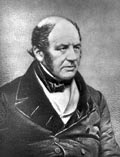
Dysaethesia Aethiopica
Encyclopedia

Psychiatry
Psychiatry is the medical specialty devoted to the study and treatment of mental disorders. These mental disorders include various affective, behavioural, cognitive and perceptual abnormalities...
, dysaethesia aethiopica was an alleged mental illness
Mental illness
A mental disorder or mental illness is a psychological or behavioral pattern generally associated with subjective distress or disability that occurs in an individual, and which is not a part of normal development or culture. Such a disorder may consist of a combination of affective, behavioural,...
described by American
United States
The United States of America is a federal constitutional republic comprising fifty states and a federal district...
physician Samuel A. Cartwright
Samuel A. Cartwright
Samuel Adolphus Cartwright was a physician who practiced in Mississippi and Louisiana in the antebellum United States. During the American Civil War he joined the Confederate States of America and was assigned the responsibility of improving sanitary conditions in the camps about Vicksburg,...
in 1851, which proposed a theory for the cause of laziness among slaves. Today, dysaethesia aethiopica is considered an example of pseudoscience
Pseudoscience
Pseudoscience is a claim, belief, or practice which is presented as scientific, but which does not adhere to a valid scientific method, lacks supporting evidence or plausibility, cannot be reliably tested, or otherwise lacks scientific status...
, and part of the edifice of scientific racism
Scientific racism
Scientific racism is the use of scientific techniques and hypotheses to sanction the belief in racial superiority or racism.This is not the same as using scientific findings and the scientific method to investigate differences among the humans and argue that there are races...
.
History
Found exclusively among BlacksAfrican American
African Americans are citizens or residents of the United States who have at least partial ancestry from any of the native populations of Sub-Saharan Africa and are the direct descendants of enslaved Africans within the boundaries of the present United States...
, dysaethesia aethiopica — "called by overseers 'rascality'" — was characterized by partial insensitivity of the skin and "so great a hebetude of the intellectual faculties, as to be like a person half asleep." Other symptoms included "lesion
Lesion
A lesion is any abnormality in the tissue of an organism , usually caused by disease or trauma. Lesion is derived from the Latin word laesio which means injury.- Types :...
s of the body discoverable to the medical observer, which are always present and sufficient to account for the symptoms." Cartwright noted that the existence of dysaethesia aethiopica was "clearly established by the most direct and positive testimony," but other doctors had failed to notice it because their "attention [had] not been sufficiently directed to the maladies of the negro race."
According to Cartwright, dysaethesia aethiopica was "much more prevalent among free negroes
Free people of color
A free person of color in the context of the history of slavery in the Americas, is a person of full or partial African descent who was not enslaved...
living in clusters by themselves, than among slaves on our plantations, and attacks only such slaves as live like free negroes in regard to diet, drinks, exercise, etc." — indeed, according to Cartwright, "nearly all [free negroes] are more or less afflicted with it, that have not got some white person to direct and to take care of them."
Cartwright felt that dysaethesia aethiopica was "easily curable, if treated on sound physiological principles." Insensitivity of the skin was one symptom of the disease, so the skin should be stimulated:
Author Vanessa Jackson has noted that lesions were a symptom of dysaethesia aethiopica and "the ever-resourceful Dr. Cartwright determined that whipping could ... cure this disorder. Of course, one wonders if the whipping were not the cause of the 'lesions' that confirmed the diagnosis."
According to Cartwright, after the prescribed "course of treatment" the slave will "look grateful and thankful to the white man whose compulsory power ... has restored his sensation and dispelled the mist that clouded his intellect."
Sources
- Samuel A. Cartwright, "Report on the Diseases and Physical Peculiarities of the Negro Race", The New Orleans Medical and Surgical Journal 1851:691-715 (May).
- Reprinted in DeBow's ReviewDeBow's ReviewDeBow's Review was a widely circulated magazine of "agricultural, commercial, and industrial progress and resource" in the American South during the upper middle of the 19th century, from 1846 until 1884. It bore the name of its first editor, James Dunwoody Brownson DeBow DeBow's Review was a...
XI (1851). Available at Google Books and excerpted at PBS.org. - Reprinted in Arthur Caplan, H. Tristram Engelhardt, Jr., and James McCartney, eds, Concepts of Health and Disease in Medicine: Interdisciplinary Perspectives (Boston: Addison-Wesley, 1980).
- Reprinted in Arthur L. Caplan, James J. McCartney, Dominic A. Sisti, eds, Health, Disease, and Illness: Concepts in Medicine (Washington, D.C.: Georgetown University Press, 2004) ISBN 1589010140.
- Reprinted in DeBow's Review

